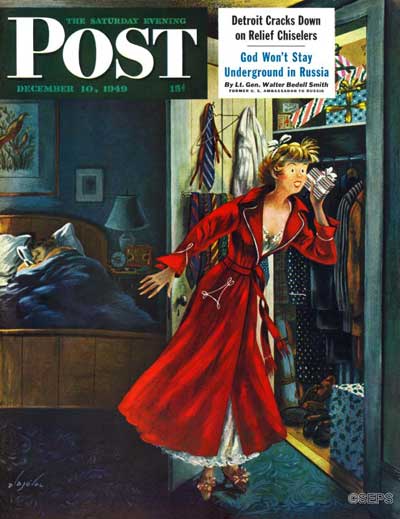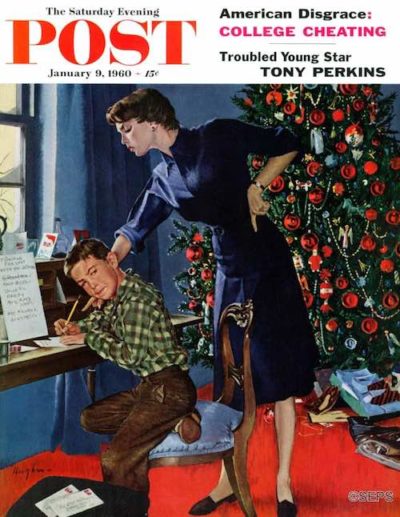Cover Collection: Holiday Fun and Silliness
Humor is like a magic trick. To succeed, it needs to look effortless, and the devices used to make it must work invisibly. Comedy is often found in the unexpected, a contrast between the serious and the frivolous or the modern and the old-fashioned. Or it may be discovered in the all-too-familiar. Such is the case here with Richard Sargent’s portrayal of a dad who is about to be vanquished by his Christmas Eve wrapping project. Sargent, who referred to himself as “king of the pregnant pause,” tended to de-emphasize an illustration’s background, drawing full attention to his subject matter.

Richard Sargent
December 19, 1959
Whatever our age, we never lose our inner child, particularly at Christmas. Russian-born Constantin Alajalov specialized in illustrations gently pointing out human frailty. While a youth in St. Petersbug, his life was disrupted by the Russian Revolution. For years he survived by painting propaganda murals and posters, but he managed to defect, first to Turkey and finally to the United States. He quickly found success in America as a muralist. His magazine careerwas launched when a friend suggested he send some paintings to The New Yorker. To his surprise, they were accepted and used as covers. He would eventually complete 74 lighthearted covers for the Post.

Constantin Alajalov
December 10, 1949
Rockwell went to extraordinary lengths to create verisimilitude. Here, instead of working in the studio, he set up his easel in Chicago’s Marshall Field’s department store even though all we see of it is the back of a sales counter. The store happily provided the setting and toys for the scene, but the artist felt the picture needed more dolls, so he went out and purchased a number of them. He reported the Post editors that he owned more dolls than any other 53-year-old-kid.

December 27, 1947
Norman Rockwell
As the camera became ubiquitous, the new tradition of the family Christmas card was taking hold. But it’s not always so easy getting everyone to cooperate. Sewell was widely known for his skill in capturing average Americans — and children in particular — with humor and affection.

Amos Sewell
December 11, 1954
We were delighted a few years ago to receive an email from Betsy Norfleet with information about the creation of this iconic 1951 cover. Betsy told us that it was her mother, Betty, who portrays the housewife directing her harried real-life husband, George. As the story goes, George was not only brutally scratched by the needles but also threw his back out posing in the scrunched-up position for house on end.

Stevan Dohanos
December 22, 1951
Dutch-born Prins turns this over into a vivid story that umps off the page like a movie sequence. Notice his clever evocation of the passage of time in the differing differing degrees of light shining (or not shining) through the kitchen window. This sweetly humorous illustration also has a wistful quality: All those weeks of preparation — the buying of gifts, the careful wrapping — then suddenly we’re left with a roomful of shredded paper.

Ben Kimberly Prins
December 27, 1958
The outdoors beckons, and there beneath the tree are some keen skates that would be great to take to the pond. Unfortunately, this young man has some work to do. It may prove to be a long afternoon, with just two letters written and five more to go.

George Hughes
January 9, 1960
 These illustrations and many others are featured in the Post’s Special Collector’s Edition, Norman Rockwell: Christmas in America. This edition can be ordered here.
These illustrations and many others are featured in the Post’s Special Collector’s Edition, Norman Rockwell: Christmas in America. This edition can be ordered here.